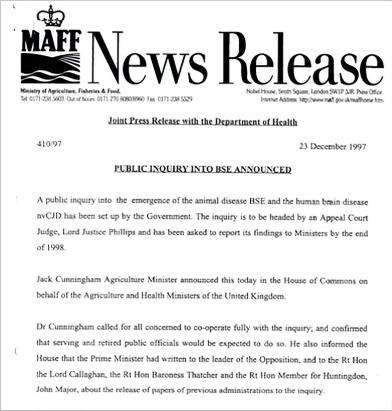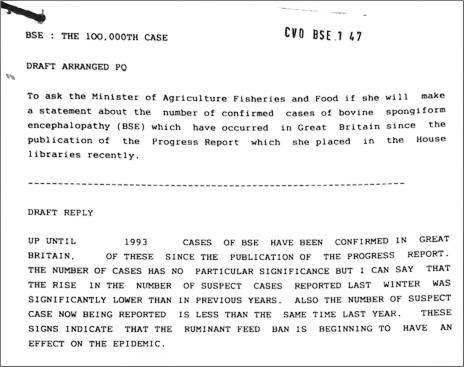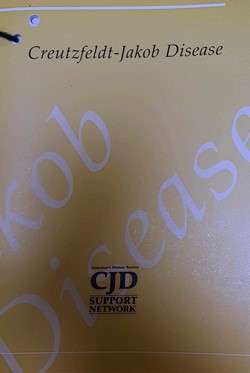What is BSE?
Bovine spongiform encephalopathy (BSE) is a fatal and progressive neurodegenerative disease affecting cattle, which spreads through the consumption of infected animal feed. BSE is a zoonosis, which means it can be transmitted to humans, through eating BSE-infected meat products causing variant Creutzfeldt Jakob Disease (vCJD).
The first BSE case was confirmed in the UK in 1986 and it grew into an epidemic, in which 4.4 million cows were destroyed for either having or suspected of having BSE.
Accessing archives during a pandemic
As I began my project in April 2020, just as the country was entering its first COVID-19 lockdown, I could not access The National Archives for the majority of the first year of my PhD. This limited my primary source material to what can be accessed digitally. For me, this was evidence gathered by the BSE Inquiry, which is accessible to the public through the UK Government Web Archive, along with the final report itself. The BSE Inquiry was formed in 1998 to investigate shortcomings in the official response to BSE, and its report was published in 2000.

PUBLIC INQUIRY INTO BSE ANNOUNCED
A public inquiry into the emergence of the animal disease BSE and the human brain disease nvCJD has been set up by the Government. The inquiry is to be headed by an Appeal Court Judge, Lord Justice Phillips and has been asked to report its findings to Ministers by the end of 1998.
Jack Cunningham Agriculture Minister announced this today in the House of Commons on behalf of the Agriculture and Health Ministers of the United Kingdom.
Dr Cunningham called for all concerned to co-operate fully with the inquiry, and confirmed that serving and retired public officials would be expected to do so. He also informed the House that the Prime Minister had written to the leader of the Opposition, and to the Rt Hon the Lord Callaghan, the Rt Hon Baroness Thatcher and the Rt Hon Member for Huntingdon, John Major, about the release of papers of previous administrations to the inquiry.
Joint MAFF and Department of Health press release announcing the establishment of the BSE Inquiry on 23 December 1997. Retrieved from the UK Government Web Archive.
The BSE Inquiry report is organised chronologically, beginning with an explanation of important BSE ‘prehistory’, or prerequisite knowledge required in order to understand and contextualise the report’s findings in later volumes. These include information on the state of post-war agriculture, the rise of intensive farming systems and slaughterhouse processes, the administrative structures of central and local governments and the nature of use of advisory committees.
Evidence collected by the Inquiry revealed that state veterinarians at the Central Veterinary Laboratory were important in influencing BSE policy. This finding determined the focus of the rest of my research: I wanted to find out how different kinds of expertise advised government, and why.
Uncovering contemporary history
My PhD project uncovers the role of veterinary scientific expertise in informing the official response to the BSE epidemic, since the disease emerged in 1985. The epidemic peaked between late 1987, when the rise in cases triggered investigations into the disease’s distribution, and around 1995 when BSE control measures saw a substantial decline in cases.
BSE was not just an issue of animal and public health: it had a significant impact on the British national economy and international trade. Beef and dairy farming were an important part of the country’s agricultural sector in the late-20th century, with home production accounting for 97% of red meat consumed domestically. Output increased further when the UK entered the European Economic Community in 1973. When BSE became a notifiable disease in 1989, meaning that suspected cases had to be reported to government, the UK faced Europe-wide bans on the export of cattle born after legal restrictions on certain types of cattle feed the previous year were implemented.
Like the BSE Inquiry, I used the papers of the Chief Veterinary Office (CVO) held at The National Archives to trace the process of BSE policymaking. They reveal the individuals and groups who were most influential in making animal and public health policy.
The CVO documents end in the year 1996 when the human vCJD dimension of the episode took precedence over animal BSE. They contain a wealth of correspondence that passed through the Office, from the Ministry of Agriculture, Fisheries and Food (MAFF) to state and academic research institutions, veterinary associations and private veterinarians. These demonstrate the Chief Veterinary Officer’s role as varied. Keith Meldrum took on this role for the majority of the BSE episode. He had less autonomy than his human health counterpart, the Chief Medical Officer, acting mostly as an advocate for animal health policy.

BSE: The 100,000th case
Draft arranged PQ
To ask the Minister of Agriculture Fisheries and Food if she will make a statement about the number of confirmed cases of bovine spongiform encephalopathy (BSE) which have occurred in Great Britain since the publication of the Progress Report which she placed in the House libraries recently.
Draft reply
Up until [space] 1993 [space] cases of BSE have been confirmed in Great Britain. [space] of these since the publication of the progress report. The number of cases has no particular significance but I can say that the rise in the number of suspect cases reported last winter was significantly longer than in previous years. Also the number of suspect cases now being reported is less than the same time last year. These signs indicate that the ruminant feed ban is beginning to have an effect on the epidemic.
Draft of announcement of the 100,000 case of BSE for then MAFF minister, Gillian Shepherd by John Howard, then Head of the Animal Health Division from June 1993. This displays state veterinary scientists in their advisory role. Catalogue reference: MAF 707/47
BSE becomes a zoonosis
Policy approaches to human and veterinary health were quite different. Once humans began to be affected, protecting public health became more of a concern than controlling the spread of disease among cows.
Documents of the Deputy Chief Medical Officer and of the Advisory Committee on Dangerous Pathogens pick up where the CVO documents leave off in 1996, giving insight into the nature of relationships between institutions responsible for vCJD patient care until 2004. Due to the 20-year transfer rule under the Public Records Act, records held by The National Archives are not accessible beyond the year 2004 at the time of writing.

An information booklet produced by the CJD Support Network charity for patients with suspected or diagnosed CJD, and their families. This was a part of the Network’s aim ‘to provide accurate, unbiased and up-to-date information and advice about all forms of CJD’. It was published in May 1998. Catalogue reference: JA 615/213
To date, 178 people have lost their lives to vCJD. The CJD Surveillance Unit has tracked the incidence of vCJD since 1990, and the National Prion Clinic continues to coordinate care for vCJD patients.
This project was completed in September 2024, uncovering the impact of the complex institutional dynamics at play throughout the BSE epidemic, and concluding that state veterinarians had much more significant agency in official responses to BSE than historians previously thought. Documents held at The National Archives, both on site and online, allowed me to faithfully reconstruct the activities of the British government and veterinary scientists at the end of the 20th century.
About the author
Isobel Newby recently undertook an Arts and Humanities Research Council-funded Collaborative Doctoral Partnership with The National Archives and the University of Leeds exploring the dynamics of decision-making during the BSE/vCJD Episode, 1981–2004. Her research explores the role of veterinary, medical and political expertise, with a focus on the agency that veterinary scientists had over the British government’s responses to Bovine Spongiform Encephalopathy (BSE).
